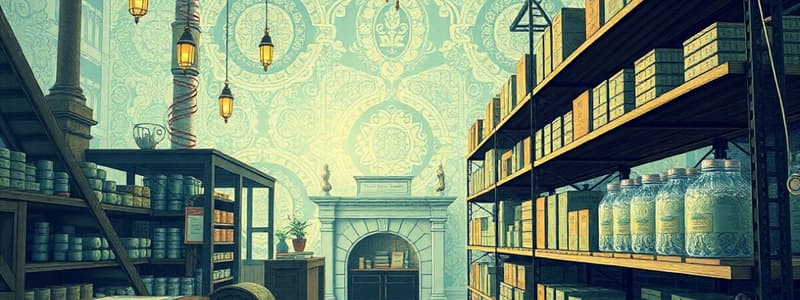Podcast
Questions and Answers
What type of demand is characterized by finished goods that are sold directly to customers and is often unpredictable?
What type of demand is characterized by finished goods that are sold directly to customers and is often unpredictable?
- Dependent Demand
- Variable Demand
- Independent Demand (correct)
- Constant Demand
Which of the following best describes demand variability?
Which of the following best describes demand variability?
- The fluctuation in demand due to various factors (correct)
- The time taken between ordering and receiving a product
- How often demand remains the same over time
- The prediction of future production needs
How is the reorder point defined in inventory management?
How is the reorder point defined in inventory management?
- The maximum inventory level before ordering more
- The inventory level at which new inventory should be ordered (correct)
- The average demand over a specific period
- The time taken to receive an order after placement
Which control characteristic involves maintaining extra inventory to prevent stockouts?
Which control characteristic involves maintaining extra inventory to prevent stockouts?
What is the optimal order quantity in inventory management?
What is the optimal order quantity in inventory management?
What characterizes dependent demand in inventory control?
What characterizes dependent demand in inventory control?
Which demand characteristic indicates a stable and predictable inventory requirement over time?
Which demand characteristic indicates a stable and predictable inventory requirement over time?
What effect does longer lead time have on inventory control?
What effect does longer lead time have on inventory control?
What does a higher inventory turnover rate indicate?
What does a higher inventory turnover rate indicate?
What is the purpose of Economic Order Quantity (EOQ)?
What is the purpose of Economic Order Quantity (EOQ)?
Which type of inventory includes raw materials that are not yet processed?
Which type of inventory includes raw materials that are not yet processed?
What is a primary consequence of stockouts?
What is a primary consequence of stockouts?
What do holding costs relate to?
What do holding costs relate to?
What technique involves ordering goods only when they are needed?
What technique involves ordering goods only when they are needed?
Which inventory valuation method assumes that the first items bought are the first ones sold?
Which inventory valuation method assumes that the first items bought are the first ones sold?
Which system is considered more accurate for tracking inventory levels?
Which system is considered more accurate for tracking inventory levels?
What does ABC analysis categorize?
What does ABC analysis categorize?
What does the Reorder Point (ROP) represent?
What does the Reorder Point (ROP) represent?
Which of the following best defines stockout costs?
Which of the following best defines stockout costs?
What characterizes Maintenance, Repair, and Overhaul (MRO) inventory?
What characterizes Maintenance, Repair, and Overhaul (MRO) inventory?
What is a potential drawback of using the Last-In, First-Out (LIFO) method?
What is a potential drawback of using the Last-In, First-Out (LIFO) method?
What is a major benefit of effective inventory management?
What is a major benefit of effective inventory management?
What is the main purpose of break-even analysis?
What is the main purpose of break-even analysis?
Which of the following is not a technique for cost optimization?
Which of the following is not a technique for cost optimization?
What does the Economic Order Quantity (EOQ) model primarily aim to minimize?
What does the Economic Order Quantity (EOQ) model primarily aim to minimize?
In deterministic inventory models, which assumption is made about demand?
In deterministic inventory models, which assumption is made about demand?
What characteristic distinguishes stochastic inventory models from deterministic models?
What characteristic distinguishes stochastic inventory models from deterministic models?
Which of the following statements about the Fixed Order Interval Model is true?
Which of the following statements about the Fixed Order Interval Model is true?
Which cost modeling software is NOT commonly used for cost tasks?
Which cost modeling software is NOT commonly used for cost tasks?
What is a key limitation of deterministic inventory models?
What is a key limitation of deterministic inventory models?
What does the Reorder Point (ROP) model primarily help businesses determine?
What does the Reorder Point (ROP) model primarily help businesses determine?
What is a common feature of both deterministic and stochastic inventory models?
What is a common feature of both deterministic and stochastic inventory models?
Which of the following describes a characteristic of cost reduction techniques?
Which of the following describes a characteristic of cost reduction techniques?
Why might businesses opt to use outsourcing as a cost optimization technique?
Why might businesses opt to use outsourcing as a cost optimization technique?
What kind of probability distributions might stochastic inventory models use?
What kind of probability distributions might stochastic inventory models use?
What is the main focus of process improvement techniques in cost modeling?
What is the main focus of process improvement techniques in cost modeling?
What is the primary benefit of having strong supplier relationships in JIT manufacturing?
What is the primary benefit of having strong supplier relationships in JIT manufacturing?
How does standardization within JIT contribute to production efficiency?
How does standardization within JIT contribute to production efficiency?
What does the principle of Jidoka emphasize in JIT manufacturing?
What does the principle of Jidoka emphasize in JIT manufacturing?
What is a key advantage of producing in small lots in JIT?
What is a key advantage of producing in small lots in JIT?
Which of the following is a disadvantage associated with JIT manufacturing?
Which of the following is a disadvantage associated with JIT manufacturing?
What does JIT aim to minimize in order to reduce costs?
What does JIT aim to minimize in order to reduce costs?
JIT manufacturing promotes continuous improvement primarily to achieve what outcome?
JIT manufacturing promotes continuous improvement primarily to achieve what outcome?
What challenge might a JIT organization face with sudden demand fluctuations?
What challenge might a JIT organization face with sudden demand fluctuations?
What is the main focus of JIT regarding quality control?
What is the main focus of JIT regarding quality control?
Which of the following illustrates an advantage of JIT concerning supplier relationships?
Which of the following illustrates an advantage of JIT concerning supplier relationships?
Which of the following options reflects a characteristic of JIT in the context of production?
Which of the following options reflects a characteristic of JIT in the context of production?
What is a key risk associated with the JIT approach?
What is a key risk associated with the JIT approach?
Why is training quicker and more efficient in a JIT system?
Why is training quicker and more efficient in a JIT system?
In JIT, how does early detection of defects contribute to product quality?
In JIT, how does early detection of defects contribute to product quality?
What is the primary purpose of demand forecasting?
What is the primary purpose of demand forecasting?
Which of these is considered a fixed cost?
Which of these is considered a fixed cost?
What defines variable costs in cost modeling?
What defines variable costs in cost modeling?
What is a break-even point?
What is a break-even point?
What does contribution margin refer to?
What does contribution margin refer to?
Which of the following is a characteristic of activity-based costing (ABC)?
Which of the following is a characteristic of activity-based costing (ABC)?
Which of the following best describes semi-variable costs?
Which of the following best describes semi-variable costs?
What is the significance of cost behavior analysis in cost modeling?
What is the significance of cost behavior analysis in cost modeling?
Which method of cost estimation involves using historical data to inform estimates for new projects?
Which method of cost estimation involves using historical data to inform estimates for new projects?
What is the purpose of cost allocation in a business?
What is the purpose of cost allocation in a business?
In cost-volume-profit (CVP) analysis, which concept represents the amount of sales that can drop before incurring losses?
In cost-volume-profit (CVP) analysis, which concept represents the amount of sales that can drop before incurring losses?
Which of the following describes direct costs?
Which of the following describes direct costs?
What does proportional allocation involve?
What does proportional allocation involve?
Non-linear costs refer to costs that:
Non-linear costs refer to costs that:
What is the primary purpose of safety stock in inventory management?
What is the primary purpose of safety stock in inventory management?
Which model is especially useful for managing single-period inventory problems?
Which model is especially useful for managing single-period inventory problems?
In the (Q, R) Model, what does 'R' represent?
In the (Q, R) Model, what does 'R' represent?
What is a key characteristic of Just-in-Time (JIT) manufacturing?
What is a key characteristic of Just-in-Time (JIT) manufacturing?
Which advantage does stochastic inventory models provide to businesses?
Which advantage does stochastic inventory models provide to businesses?
What does Continuous Improvement (Kaizen) in JIT emphasize?
What does Continuous Improvement (Kaizen) in JIT emphasize?
Which of the following is a limitation of stochastic inventory models?
Which of the following is a limitation of stochastic inventory models?
What is the difference between 's' and 'S' in the (s, S) model?
What is the difference between 's' and 'S' in the (s, S) model?
What is a common misconception regarding JIT manufacturing?
What is a common misconception regarding JIT manufacturing?
What determines the reorder point in a (Q, R) model?
What determines the reorder point in a (Q, R) model?
How does the Periodic Review Model adjust inventory levels?
How does the Periodic Review Model adjust inventory levels?
Which of the following is NOT an element of waste in JIT manufacturing?
Which of the following is NOT an element of waste in JIT manufacturing?
What impact do stochastic models have on decision-making in inventory management?
What impact do stochastic models have on decision-making in inventory management?
In JIT, how are excess inventory levels treated?
In JIT, how are excess inventory levels treated?
Flashcards
Independent Demand
Independent Demand
Demand for finished goods sold directly to customers; unpredictable.
Dependent Demand
Dependent Demand
Demand for components/parts used in production; predictable; linked to production schedule.
Constant Demand
Constant Demand
Stable and predictable demand over time.
Variable Demand
Variable Demand
Signup and view all the flashcards
Reorder Point
Reorder Point
Signup and view all the flashcards
Order Quantity
Order Quantity
Signup and view all the flashcards
Safety Stock
Safety Stock
Signup and view all the flashcards
Lead Time
Lead Time
Signup and view all the flashcards
Inventory Turnover
Inventory Turnover
Signup and view all the flashcards
EOQ (Economic Order Quantity)
EOQ (Economic Order Quantity)
Signup and view all the flashcards
Stock Control Systems
Stock Control Systems
Signup and view all the flashcards
Inventory
Inventory
Signup and view all the flashcards
Raw Materials
Raw Materials
Signup and view all the flashcards
Work-in-Progress (WIP)
Work-in-Progress (WIP)
Signup and view all the flashcards
Finished Goods
Finished Goods
Signup and view all the flashcards
MRO Inventory
MRO Inventory
Signup and view all the flashcards
Ordering Costs
Ordering Costs
Signup and view all the flashcards
Holding Costs
Holding Costs
Signup and view all the flashcards
Stockout Costs
Stockout Costs
Signup and view all the flashcards
Just-in-Time (JIT) Inventory
Just-in-Time (JIT) Inventory
Signup and view all the flashcards
Reorder Point (ROP)
Reorder Point (ROP)
Signup and view all the flashcards
ABC Analysis
ABC Analysis
Signup and view all the flashcards
Cost Modeling
Cost Modeling
Signup and view all the flashcards
Fixed Costs
Fixed Costs
Signup and view all the flashcards
Variable Costs
Variable Costs
Signup and view all the flashcards
Semi-Variable Costs
Semi-Variable Costs
Signup and view all the flashcards
Direct Costs
Direct Costs
Signup and view all the flashcards
Indirect Costs
Indirect Costs
Signup and view all the flashcards
Cost Behavior Analysis
Cost Behavior Analysis
Signup and view all the flashcards
Linear Costs
Linear Costs
Signup and view all the flashcards
Non-Linear Costs
Non-Linear Costs
Signup and view all the flashcards
Step Costs
Step Costs
Signup and view all the flashcards
Break-even Point
Break-even Point
Signup and view all the flashcards
Contribution Margin
Contribution Margin
Signup and view all the flashcards
Margin of Safety
Margin of Safety
Signup and view all the flashcards
Activity-Based Costing (ABC)
Activity-Based Costing (ABC)
Signup and view all the flashcards
Break-even Analysis
Break-even Analysis
Signup and view all the flashcards
Cost Optimization
Cost Optimization
Signup and view all the flashcards
Cost Reduction Techniques
Cost Reduction Techniques
Signup and view all the flashcards
Deterministic Inventory Models
Deterministic Inventory Models
Signup and view all the flashcards
Fixed Lead Time
Fixed Lead Time
Signup and view all the flashcards
Economic Order Quantity (EOQ)
Economic Order Quantity (EOQ)
Signup and view all the flashcards
Fixed Order Quantity Model
Fixed Order Quantity Model
Signup and view all the flashcards
Fixed Order Interval Model
Fixed Order Interval Model
Signup and view all the flashcards
Stochastic Inventory Models
Stochastic Inventory Models
Signup and view all the flashcards
Uncertainty in Demand
Uncertainty in Demand
Signup and view all the flashcards
Uncertainty in Lead Time
Uncertainty in Lead Time
Signup and view all the flashcards
Probabilistic Approach
Probabilistic Approach
Signup and view all the flashcards
Cost Modeling Software
Cost Modeling Software
Signup and view all the flashcards
Newsvendor Model
Newsvendor Model
Signup and view all the flashcards
Order Quantity (Q)
Order Quantity (Q)
Signup and view all the flashcards
Periodic Review Model
Periodic Review Model
Signup and view all the flashcards
(s, S) Model
(s, S) Model
Signup and view all the flashcards
Advantages of Stochastic Inventory Models
Advantages of Stochastic Inventory Models
Signup and view all the flashcards
Limitations of Stochastic Inventory Models
Limitations of Stochastic Inventory Models
Signup and view all the flashcards
Just-in-Time (JIT) Manufacturing
Just-in-Time (JIT) Manufacturing
Signup and view all the flashcards
Elimination of Waste (JIT)
Elimination of Waste (JIT)
Signup and view all the flashcards
Demand-Driven Production (JIT)
Demand-Driven Production (JIT)
Signup and view all the flashcards
Inventory Reduction (JIT)
Inventory Reduction (JIT)
Signup and view all the flashcards
Continuous Improvement (Kaizen) (JIT)
Continuous Improvement (Kaizen) (JIT)
Signup and view all the flashcards
JIT Manufacturing
JIT Manufacturing
Signup and view all the flashcards
Strong Supplier Relationships
Strong Supplier Relationships
Signup and view all the flashcards
Standardized Work Processes
Standardized Work Processes
Signup and view all the flashcards
Quality Control (Jidoka)
Quality Control (Jidoka)
Signup and view all the flashcards
Small Lot Production
Small Lot Production
Signup and view all the flashcards
Reduced Inventory Costs
Reduced Inventory Costs
Signup and view all the flashcards
Increased Efficiency
Increased Efficiency
Signup and view all the flashcards
Improved Product Quality
Improved Product Quality
Signup and view all the flashcards
Greater Flexibility
Greater Flexibility
Signup and view all the flashcards
Reduced Waste
Reduced Waste
Signup and view all the flashcards
Better Supplier Relationships
Better Supplier Relationships
Signup and view all the flashcards
Supply Chain Risks
Supply Chain Risks
Signup and view all the flashcards
Higher Transportation Costs
Higher Transportation Costs
Signup and view all the flashcards
Dependence on Suppliers
Dependence on Suppliers
Signup and view all the flashcards
Implementation Complexity
Implementation Complexity
Signup and view all the flashcards
Study Notes
Demand and Control Systems Characteristics
-
Inventory control relies on understanding demand and control characteristics to optimize stock levels.
-
Demand characteristics detail how products are ordered, stored, and replenished.
-
Demand Type:
- Independent Demand: Demand for finished goods, unpredictable, affected by market trends, customer preferences, and seasonality.
- Dependent Demand: Demand for components/raw materials, predictable, based on production schedules.
-
Demand Variability:
- Constant Demand: Stable and predictable.
- Variable Demand: Fluctuates due to seasonality, trends, promotions.
-
Lead Time: Time between ordering and receiving, impacts inventory control.
-
Control characteristics manage inventory levels to meet demand without excessive stock.
-
Reorder Point: Inventory level triggering new order placement. Calculated from lead time and expected demand.
-
Order Quantity: Amount ordered each time. Balances ordering and holding costs.
-
Safety Stock: Extra inventory for demand/supply chain uncertainties. Prevents stockouts.
-
Inventory Turnover: Frequency of inventory sales and replacement. High turnover indicates efficiency.
-
Economic Order Quantity (EOQ): Optimal order quantity to minimize total inventory costs.
-
Stock Control Systems: Manual, barcoded, or automated systems to monitor stock and track sales.
Inventory
-
Inventory is goods held for resale, production, or use. Crucial for business operations to ensure product availability and minimize costs.
-
Types of Inventory:
- Raw Materials: Basic components, not yet processed.
- Work-in-Progress (WIP): Partially completed goods.
- Finished Goods: Complete products ready for sale.
- Maintenance, Repair, and Overhaul (MRO) Inventory: Supplies for equipment maintenance.
-
Inventory Management: Strategies and techniques to control inventory flow.
-
Inventory Turnover: Measures how often inventory is sold and replaced. Higher turnover suggests efficient inventory control.
-
Stockouts and Overstocking: Risks of running out of stock or holding excess inventory, respectively, leading to missed sales or higher costs.
-
Inventory Cost Concepts:
- Ordering Costs: Costs incurred when placing and receiving orders, including shipping, handling and administrative expenses.
- Holding Costs: Costs of storing and maintaining inventory, including warehousing, insurance, capital tied up in inventory.
- Stockout Costs: Costs caused by running out of stock, including lost sales and potential damage to the business's reputation.
-
Inventory Control Techniques:
- EOQ: Minimizes total inventory costs.
- JIT: Minimizes inventory by ordering goods only when needed.
- Reorder Point (ROP): Inventory level triggering an order.
- Safety Stock: Buffer against demand fluctuations or supply chain disruptions.
-
Inventory Valuation Methods:
- FIFO (First-In, First-Out): Assumes first items purchased are the first sold.
- LIFO (Last-In, First-Out): Assumes most recent items are the first sold. Less common than FIFO.
- Weighted Average Cost: Average cost assigned to all inventory units.
-
Inventory Control Systems:
- Manual Systems: Basic systems for tracking inventory levels manually.
- Automated Systems: Software or ERP systems for real-time inventory tracking.
-
ABC Analysis: Categorizes inventory based on value to prioritize management efforts.
- A-Items: High-value items, needing high control.
- B-Items: Moderate-value items.
- C-Items: Low-value items, needing less frequent control.
-
Demand Forecasting: Essential for maintaining right inventory levels, predicts future demand based on historical data and trends.
Costs Modeling
-
Cost modeling estimates and analyses costs related to business activities.
-
Types of Costs:
- Fixed Costs: Independent of production level.
- Variable Costs: Change directly with production level.
- Semi-Variable Costs: Mix of fixed and variable costs.
- Direct Costs: Traceable to a specific product.
- Indirect Costs: Not directly traceable to one product.
-
Cost Behavior Analysis: Examines how costs react to changes in activity.
- Linear Costs: Proportional changes with activity.
- Non-Linear Costs: Non-proportional changes.
- Step Costs: Constant within ranges but increase when thresholds are passed, e.g., additional personnel.
-
Cost-Volume-Profit (CVP) Analysis: Relates costs, volume, sales, and profits.
- Break-Even Point: Total revenue equals total costs.
- Contribution Margin: Selling price minus variable cost.
- Margin of Safety: Difference between actual sales and break-even sales.
-
Activity-Based Costing (ABC): More detailed costing method, allocates overhead based on activities.
-
Cost Allocation: Assigns indirect costs to cost objects.
- Direct Allocation.
- Proportional Allocation.
- Activity-Based Allocation.
-
Cost Estimation: Estimating costs for new products or initiatives
- Analogous Estimating: Based on historical data.
- Parametric Estimating: Based on relationships between variables.
- Bottom-Up Estimating: Starts from components.
- Top-Down Estimating: Based on broad historical data or percentages.
-
Break-Even Analysis: Crucial for determining minimum sales for profitability.
-
Cost Optimization and Control: Techniques to minimize expenses
- Cost Reduction
- Outsourcing
- Process Improvement
Deterministic Inventory Models
-
Deterministic inventory models handle predictable demand and lead times.
-
Key Features:
- Constant Demand: Predictable
- Fixed Lead Time: No variations
- No Stockouts: Ensures sufficient inventory.
- Predetermined Replenishment: Known order quantities and timings.
-
Common Models:
- Economic Order Quantity (EOQ): Minimizes total inventory costs. Formula calculates optimal order quantity.
- Reorder Point (ROP): Determines when to order inventory to avoid stockouts.
- Fixed Order Quantity Model: Fixed order quantities at pre-set points.
- Fixed Order Interval Model: Fixed order intervals.
-
Advantages: Simple, Predictable, Cost Optimization.
-
Limitations: Unrealistic assumptions often do not represent real-world situations.
Stochastic Inventory Models
-
Stochastic models accommodate uncertainty in demand and lead times.
-
Key Features:
- Uncertain Demand and Lead Time: Probabilistic, not predetermined.
- Probabilistic Approach: Use probabilities to estimate outcomes.
- Stockouts and Safety Stock: Incorporates safety stock to mitigate stockouts.
-
Common Models:
- Newsvendor Model: Manages single-period inventory for uncertainty.
- (Q, R) Model: Fixed order quantities, reorder points considered.
- Periodic Review Model: Checks at intervals, adjusts order quantity.
- (s, S) Model: Places orders to bring inventory to target levels.
-
Advantages: Handles uncertainty, improves decision-making, flexible.
-
Limitations: More complex, requires reliable data.
Just-in-Time Manufacturing
-
JIT manufacturing produces goods only when needed for the production process.
-
Key Principles:
- Waste Elimination: Focuses on minimizing waste in all areas.
- Demand-Driven Production: Aligns production with customer demand.
- Inventory Reduction: Minimizes inventory costs and risk.
- Continuous Improvement (Kaizen): Aims for continuous improvement in processes.
- Strong Supplier Relationships: Crucial for on-time deliveries.
- Standardized Work Processes: Ensures efficiency and consistency.
- Quality Control (Jidoka): Integrates quality into each stage.
- Small Lot Production: Smaller production batches.
-
Advantages: Reduced inventory costs, increased efficiency, improved quality, greater flexibility, reduced waste.
-
Challenges: Supply chain risks, higher transportation cost, dependence on suppliers, implementation complexity, demand fluctuations.
Studying That Suits You
Use AI to generate personalized quizzes and flashcards to suit your learning preferences.





